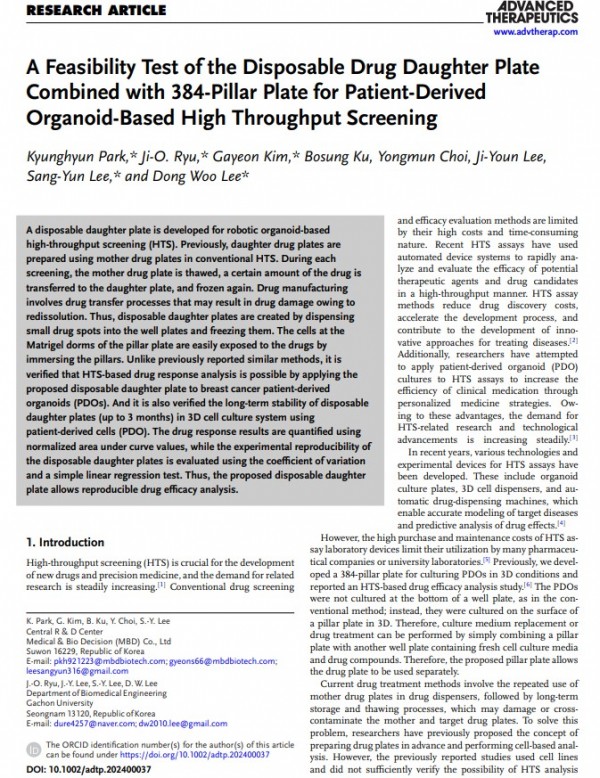논문 2024, Advanced Therapeutics, A Feasibility Test of the Disposable Drug…
페이지 정보

본문
Abstract
A disposable daughter plate is developed for robotic organoid-based high-throughput screening (HTS).
Previously, daughter drug plates are prepared using mother drug plates in conventional HTS.
During each screening, the mother drug plate is thawed, a certain amount of the drug is transferred to the daughter plate,
and frozen again. Drug manufacturing involves drug transfer processes that may result in drug damage owing to redissolution.
Thus, disposable daughter plates are created by dispensing small drug spots into the well plates and freezing them.
The cells at the Matrigel dorms of the pillar plate are easily exposed to the drugs by immersing the pillars.
Unlike previously reported similar methods, it is verified that HTS-based drug response analysis is possible by applying the
proposed disposable daughter plate to breast cancer patient-derived organoids (PDOs).
And it is also verified the long-term stability of disposable daughter plates (up to 3 months) in 3D cell culture system using patient-derived cells (PDO).
The drug response results are quantified using normalized area under curve values, while the experimental reproducibility of
the disposable daughter plates is evaluated using the coefficient of variation and a simple linear regression test. Thus, the proposed disposable daughter
plate allows reproducible drug efficacy analysis.
A disposable daughter plate is developed for robotic organoid-based high-throughput screening (HTS).
Previously, daughter drug plates are prepared using mother drug plates in conventional HTS.
During each screening, the mother drug plate is thawed, a certain amount of the drug is transferred to the daughter plate,
and frozen again. Drug manufacturing involves drug transfer processes that may result in drug damage owing to redissolution.
Thus, disposable daughter plates are created by dispensing small drug spots into the well plates and freezing them.
The cells at the Matrigel dorms of the pillar plate are easily exposed to the drugs by immersing the pillars.
Unlike previously reported similar methods, it is verified that HTS-based drug response analysis is possible by applying the
proposed disposable daughter plate to breast cancer patient-derived organoids (PDOs).
And it is also verified the long-term stability of disposable daughter plates (up to 3 months) in 3D cell culture system using patient-derived cells (PDO).
The drug response results are quantified using normalized area under curve values, while the experimental reproducibility of
the disposable daughter plates is evaluated using the coefficient of variation and a simple linear regression test. Thus, the proposed disposable daughter
plate allows reproducible drug efficacy analysis.
관련링크
- 이전글
 2024, NPJ Precision Oncology, Prediction of TKI response in EGFR-mutant lung cancer patients-derived organoids using malignant pleural effusion 24.05.22
2024, NPJ Precision Oncology, Prediction of TKI response in EGFR-mutant lung cancer patients-derived organoids using malignant pleural effusion 24.05.22 - 다음글
 2024, Frontiers in Bioengineering and Biotechnology, Two-dimensional segmentation fusion tool: an extensible, free-to-use, user-friendly tool for combining different bidimensional segmentations 24.02.01
2024, Frontiers in Bioengineering and Biotechnology, Two-dimensional segmentation fusion tool: an extensible, free-to-use, user-friendly tool for combining different bidimensional segmentations 24.02.01

